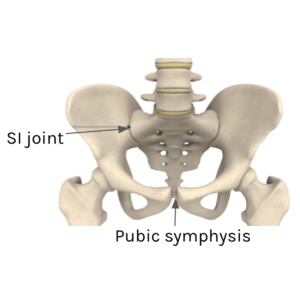What is the sacroiliac (SI) joint?
- The pelvis is a ring of bone that contains three joints. One is in the front (the pubic symphysis) and the other two are in the back on either side of the sacrum (the SI joints).
- The SI joints are extremely stable, only allowing 2-4 mm of movement. This stability is created by the shape of the bones, the weight of our body, the action of muscles, and a network of thick connective tissue. The SI joints can only be disrupted by trauma, such as car accidents.

What is SI joint pain?
- Pain at or near one or both of the sacroiliac joints, with no symptoms radiating down the leg. It is similar to low back pain, but usually presents more locally in the area of the joint.
- People with SI joint pain usually experience pain when walking, getting in and out of bed, and standing on one leg. During exercise, they may experience pain with running, lunges, step ups, and other asymmetrical movements.
- People with SI joint pain also can experience pubic symphysis pain. You can read more about pubic symphysis pain here!
Who experiences SI joint pain?
- SI joint pain most commonly occurs in pregnancy, and it can continue postpartum for a smaller number of people. Studies estimate that about 20% of pregnant people will experience SI joint pain.
- SI joint pain can also occur in a lower percentage of non-pregnant people, and is generally more common in women under 30.
What causes SI joint pain?
- SI joint pain results from a combination of factors unique to each individual. Biomechanical factors may be important for many people. While hormonal changes in pregnancy increase the movement in the SI joints, increased joint mobility does not itself cause pain.
- Asymmetry of movement in the SI joints appears to be the important factor that increases risk of pain. This increases the forces being absorbed by one joint when doing asymmetrical movements like standing on one leg.
- SI joint pain therefore is a sensitivity to force through the joint, but does not indicate damage to the tissues.
I heard that SI joint pain is because of misalignment of my pelvic joints. Is that true?
- While many providers still talk about “pelvic misalignment” as the cause of SI joint pain, there is no reliable evidence that this is the case. Years of research shows that it is not possible to detect pelvic joint alignment through touching or observing a patient.
- The treatments that are frequently used to “correct alignment” can often feel good and helpful! However, this isn’t because the joint alignment was changed. Contracting muscles and creating movement around a painful area is often helpful for improving pain in many areas of the body.
- Many people who are concerned about joint alignment are also worried to move normally and participate in their desired exercise. We don’t want anyone to be limited in their movement because of this fear – your pelvis is strong and stable, even if you have pain!

How can physical therapy help?
- If your symptoms are severe, temporarily resting from aggravating activities is generally a good idea. However, staying active within a mild to moderate degree of pain is safe and advisable. Your PT can help you navigate your daily activity and exercise program to make sure you can stay moving as much as possible.
- Once your symptoms are calmed down, we can start building back up! We use an exercise-based approach that focuses on building strength in the pelvic floor, abdominals, back, hips, and thighs. By building strength and challenging your body, we can increase tolerance for painful movements and get you back up to speed!
- Many find relief from a pelvic support belt. If this works for you, feel free to use it to keep yourself moving! This is best used as a temporary measure, as we don’t want you to have to rely on it forever.
- If movements in bed or getting out of the car are painful, try keeping your legs together (“move like a mermaid”). Your PT can help you troubleshoot bothersome movements if you’re still having trouble.
